2015 Scientific Program Offers Food Safety & Quality
FOOD SAFETY & QUALITY PREVIEW
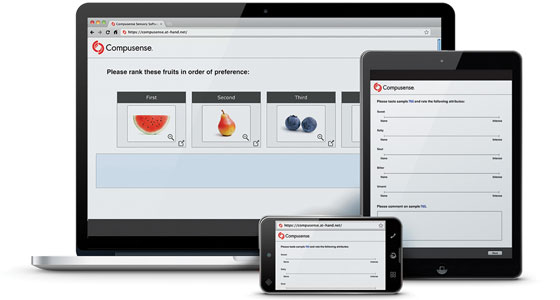
The Scientific Program at IFT15 in Chicago, July 11–14, 2015, will feature 112 sessions, including more than 350 oral presentations and 1,248 poster papers, that food scientists and related professionals will find valuable. The following are brief descriptions of symposia related to food safety and quality.
Food Safety
In session 002, “The Science Behind the Safety: Exploring Global Challenges to Natural and Synthetic Colors,” on Sunday, July 12, from 7:15 a.m. to 8:15 a.m., George Pugh and David Schoneker will focus on the science and history of the safe use of synthetic and natural colors and the challenges posed by international regulations and a misinformed public.
In session 003, “Emerging Biocontrol Strategies for Food Safety,” on Sunday, July 12, from 7:15 a.m. to 8:15 a.m., Tim McAllister will discuss genomic, proteomic, and physiological characterization of a bacteriophage for control of Shiga toxin-producing Escherichia coli (STEC) in cattle, Alexander Sulakvelidze will discuss the postharvest application of a lytic bacteriophage to foods and food processing surfaces for inhibition of pathogens, Arun Bhunia will discuss the use of bioengineered probiotic organisms to combat pathogens, and Suresh Pillai will describe how modulation of bacterial quorum sensing activity in foods can disrupt the production of biofilms.
In session 014, “Preventing Economically Motivated Adulteration of Foods: The Perspectives of Stakeholders in Industry, Regulatory Agencies, and Academia,” on Sunday, July 12, from 8:30 a.m. to 10:00 a.m., Karen Everstine will describe economically motivated adulteration (EMA), Gale Prince will discuss EMA and food fraud and the groups involved in EMA prevention and mitigation, Jonathan DeVries will describe the U.S. Pharmacopeial Convention’s guidance document on determining food fraud vulnerability, and Tim Sonntag will discuss the inclusion of EMA in the proposed Food Safety Modernization Act’s “Current Good Manufacturing Practice and Hazard Analysis and Risk-Based Preventive Controls for Human Food” rule.
In session 015, “Challenges and Opportunities for Commercial Biosensors,” on Sunday, July 12, from 8:30 a.m. to 10:00 a.m., Yanbin Li will discuss development of electrochemical and optical biosensors for rapid detection of Salmonella Typhimurium and E. coli O157:H7 in food samples, Jonathan Claussen will discuss use of ink-jet-printed graphene paper as a disposable electrochemical biosensor for monitoring meat spoilage, Daniel Jenkins will describe development of a handheld instrument based on loop-mediated isothermal nucleic acid amplification, and Ramaraja Ramasamy will discuss opportunities and challenges in use of bio-nanocomposite-based electrochemical biosensors for detection of pathogens.
In session 017, “Food Science and Technology: A Vision for the Future,” on Sunday, July 12, from 8:30 a.m. to 10:00 a.m., Manan Sharma will discuss current and future needs in food microbiology and safety research to help in education regarding new food preservation technologies; Janet Collins will discuss regulatory implications of trends regarding food quality and safety to help incorporate regulations into a food science curriculum; Lester Wilson will describe new models for higher education in food science and emphasize the need for professional certification; and John Litchfield will present a global vision of developments in food science and technology, including food innovations and new food processing technologies.
In session 035, “Risk Assessment: Which Approach Is Best for Food Ingredients and Contaminants?” on Sunday, July 12, from 1:30 p.m. to 3:00 p.m., Mike Dourson will describe use of the benchmark dose, the first adverse effect in the dose scale as dose increases; Alan Boobis will discuss the threshold of toxicological concern (TTC) approach, which provides assurance that the levels of a substance in food are so low that no further data are needed to complete the risk assessment; and Ray Matulka will address whether harmonization of the different approaches that food safety organizations around the world have adopted for determining the safety of constituents in foods and beverages is possible.
In session 039, “Gaseous, Vaporized, and Aerosolized Antimicrobials to Enhance Microbial Food Safety,” on Sunday, July 12, from 1:30 p.m. to 3:00 p.m., Vivian Wu will discuss the use of chlorine dioxide and ozone to reduce the microbial load on fresh produce; Randy Worobo will discuss application of vaporized ethyl pyruvate for decontamination of green onions and spinach; Tony Jin will describe a method for release of gaseous antimicrobials from packaging films and coatings for nonthermal in-package pasteurization of ready-to-eat foods; Xuetong Fan will describe the introduction of aerosolized antimicrobials such as chlorine dioxide, peroxyacetic acid, and organic acids into packages of tomatoes to inactivate pathogens; and Christopher Doona will describe chlorine dioxide decontamination technologies for sanitizing fresh produce and food contact surfaces.
In session 060, “Shedding Light on Food Safety: Applications of Light-Based Technologies,” on Monday, July 13, from 10:00 a.m. to 11:30 a.m., Kathiravan Krishnamurthy will describe light-based technologies and their pathogen-inactivation mechanisms and applications; Tatiana Koutchma will discuss advances and challenges regarding ultraviolet (UV) light processing of juices, milk, and other beverages; Carmen Moraru will discuss use of pulsed light and light-emitting diodes (LEDs) to inactivate microorganisms and spores; and Nathan Anderson will address process validation of nonthermal and nonchemical alternatives to traditional preservation processes.
In session 076, “How Good Is Your Food Supply Chain at Reducing and Preventing Contaminants?” on Monday, July 13, from 12:30 p.m. to 2:00 p.m., Claire L. Kruger will describe risk-assessment methods used to set limits for contaminants, Dieter Schrenk will compare the precautionary principle and the TTC approaches for assessing the risk of food contaminants, Roger Clemens will discuss the provision of the Food Safety Modernization Act (FSMA) that requires enhanced tracking and tracing of food and record keeping, and Joy Joseph will discuss the impact on the food and dietary supplement industries of the proposed preventive controls for human food and the foreign supplier verification.
In session 111, “Food Safety Education for Small and Medium Food Processors in the Indian Subcontinent and Other Developing Regions,” on Tuesday, July 14, from 10:30 a.m. to 12:00 p.m., Syed Rizvi will discuss the need to enhance technical information transfer to small- and medium-sized processors in India and other developing countries at minimal cost; Vijay Vijayaraghavan will address innovation in food safety education and training to enable the highly decentralized food ingredient supply chain in India to comply with global food safety requirements; Kathiravan Krishnamurthy will relate collaborative efforts by academia, industry, and government in educating and training food safety leaders in India and developing countries; and Ramkishan Rao will discuss challenges in food safety regulatory compliance in the Indian subcontinent and neighboring developing countries.
In session 117, “Food Safety Across the Pacific,” on Tuesday, July 14, from 1:15 p.m. to 2:45 p.m., Barbara Rasco will discuss how new regulatory frameworks based on the FSMA and Chinese law could affect food safety and trade in East Asia and across the Pacific; Shuo Wang will discuss the importance of methods for the detection of chemical contaminants in foods in China; Xiaonan Lu will describe rapid methods to monitor foodborne pathogens and high-throughput systems for screening pathogens; Gleyn Bledsoe will discuss intervention strategies developed in Korea and across the region to reduce the risk of foodborne diseases; and Rickey Yada will discuss nanotechnology and food safety issues affecting trade between the United States, China, Canada, and South Korea.
In session 122, “Global Disasters and Food: An Inextricable Collision,” on Tuesday, July 14, from 1:15 p.m. to 2:45 p.m., John Hoffman will illustrate how disasters involve a variety of public health concerns, including food safety, security, and defense, and how the food industry and regulators must react with regard to risk assessment, decision making, and the impact of global disaster on the food system.
In session 119, “Heavy Metal Contamination in Food: Health Hazards and Detoxification Strategies,” on Tuesday, July 14, from 1:15 p.m. to 2:45 p.m., Debasis Bagchi will discuss cadmium contamination in foods, its relationship to oxidative stress and carcinogenesis, and how nutraceuticals, functional foods, and antioxidants can reduce cadmium-induced cellular injury; Narayan Chakrabarty will address arsenic toxicity and how technologies such as supercritical extraction and nutraceuticals can significantly reduce arsenic toxicity; Sreejayan Nair will discuss lead toxicity and the active components of plant-based antioxidants credited with preventing lead toxicity; and Manashi Bagchi will address mercury toxicity, technologies to significantly reduce mercury contamination in processed phytochemicals and nutraceuticals, and the role of Bacopa monniera in mitigating mercury toxicity.
--- PAGE BREAK ---
Food Quality
In session 008, “Future of Food Preservatives: Emerging Natural and Potent Alternatives,” on Sunday, July 12, from 8:30 a.m. to 10:00 a.m., Ahmed Yousef will discuss the potential use of recently discovered antimicrobial peptides as food preservatives, Randy Worobo will describe research on antifungal proteins and their potential use in food preservation, and Larry Steenson and Jairus David will discuss factors that the industry must consider regarding use of natural antimicrobials in food.
In session 025, “Applications of 3-D Printing in the Improvement of Food Quality,” on Sunday, July 12, from 10:30 a.m. to 12:00 p.m., Hod Lipson will discuss 3-D printing of food and the opportunities and challenges ahead, Anshul Dubey will tell how 3-D printing is being used in food and snack food development, and Mary Scerra will describe the military’s planned research and development efforts in 3-D food printing for field feeding.
In session 026, “Increasing Freshness in Fresh Prepared Foods,” on Sunday, July 12, from 10:30 a.m. to 12:00 p.m., Agnes Lapinska and Poulson Joseph will discuss the challenges regarding stability of meat in the fresh foods section of the grocery store, Catherine Proper will discuss opportunities and challenges food retailers face in preserving the freshness of foods, and John Garrison will address use of functional clean-label native starches to provide refrigerated storage stability while preserving the perception of freshness.
In session 027, “Ingredient and Methodology Strategies in Developing Gluten-Free Bakery Formulations,” on Sunday, July 12, from 10:30 a.m. to 12:00 p.m., Anh Nguy will discuss use of gluten-free starches and pulse flours to produce gluten-free bakery products with acceptable texture, appearance, and flavor; Steven Baker will show how use of gums can overcome the low volume, firm and crumbly texture, poor processing characteristics, and off-flavors common with gluten-free bakery goods; and Jo Anna Popielarski will describe analytical technologies such as texture analysis, rheometry, differential scanning calorimetry, and time-domain nuclear magnetic resonance that can be used in development of gluten-free products.
In session 075, “Prevention of Lipid Oxidation: New Strategies, Antioxidants, and Evaluation Methods,” on Monday, July 13, from 12:30 p.m. to 2:00 p.m., Fereidoon Shahidi will discuss how increasing the lipophilicity of naturally occurring antioxidants can enhance the stability of lipids in food and biological systems; Eric Decker will describe use of a cracker model system to study pro-oxidative mechanisms, lipid distribution, and antioxidant efficacy under low-moisture conditions; Eunok Choe will present results of a study of soybean phospholipids as antioxidants in an oil-water emulsion; and S.P.J. Namal Senanayake will discuss rapid screening methods to measure antioxidant efficacy in foods.
Health and Nutrition
In session 005, “Limiting in the American Diet: Calcium, Dietary Fiber, Potassium, Vitamins E and D. Why?” on Sunday, July 12, from 7:15 a.m. to 8:15 a.m., Dennis Gordon will discuss intake levels of calcium and dietary fiber and ways to improve their levels in the food supply, Guy Johnson will do the same for potassium, and Michael McBurney will do the same for vitamins E and D.
In session 009, “Setting the Science Straight on No- and Low-Calorie Sweeteners,” on Sunday, July 12, from 8:30 a.m .to 10:00 a.m., Victor Fulgoni will relate trends in consumption of low-calorie sweetened beverages, Hope Warshaw will review a meta-analysis of no- and low-calorie sweeteners and weight control and randomized control trials of diet beverages vs. water on body weight and metabolism, and Kris Sollid will discuss consumer perceptions of no- and low-calorie sweeteners.
In session 011, “Outlook on Healthy Oils: New Science, New Guidelines,” on Sunday, July 12, from 8:30 a.m. to 10:00 a.m., Penny Kris-Etherton will discuss the rationale behind recently issued dietary guidance on fats and oils; Cyril Kendall will discuss the role of fatty acids in the diet and their relationship to carbohydrate intake and cardiometabolic syndrome; and Dave Dzisiak will describe new-generation oils that can provide health, taste, functionality, and clean labeling.
In session 022, “The Potential Effect of Low Calorie Sweeteners (LCS) on Human Health by Affecting the Microbiota Composition and Function Within the Gastrointestinal Tract,” on Sunday, July 12, from 10:30 a.m. to 12:00 p.m., Lee Grotz will discuss the process required to support regulatory approval of sweeteners, including non-clinical and clinical research; Ian Rowland will describe factors in gut microflora research that are important for use in predicting human health outcomes related to consumption of LCS; and Ashley Roberts will present research indicating that artificial sweeteners have the potential to induce glucose intolerance by altering the gut microflora.
In session 023, “Choline: An Important Nutrient Often Overlooked,” on Sunday, July 12, from 10:30 a.m. to 12:00 p.m., Steven Zeisel will address the role of choline in brain development and cognition and its relevance to health; Marie Caudill will discuss the role of choline during pregnancy, prevention of neural tube defects, proper fetal development, and choline fortification of infant formula; and Taylor Wallace will discuss sources of choline in the diet as well as opportunities and barriers to including choline in functional foods.
In session 037, “Adding Value to Food and Nutrition Through Probiotics: Present Status and Future Perspective,” on Sunday, July 12, from 1:30 p.m. to 3:00 p.m., J.B. Prajapati will discuss how research on probiotics is progressing and can be applied to food science and technology; Suja Senan will illustrate how a combination of protein and probiotics can play a significant role in controlling weight and obesity; James Steele will discuss how genomics can help identify potential microbial biomarkers for studying probiotic responsiveness in hosts, which may lead to personalized nutrition; and Arthur Ouwehand will describe a human gastrointestinal-tract model that has correlated well with clinical study results to prove the efficacy of probiotics.
In session 040, “New Frontiers in Dietary Fiber: Health and Nutrition Benefits,” on Sunday, July 12, from 1:30 p.m. to 3:00 p.m., David Klurfeld will discuss the importance of providing dietary fiber and other nutrients to the bacteria in the colon, David Plank will describe a modification to the Codex dietary fiber methods that uses high-speed centrifugation in place of celite/crucible filtration, Barry McCleary will discuss how a modification of AOAC Method 2009.01 for the measurement of total dietary fiber has resolved the method’s limitations, and Jonathan DeVries will discuss dietary fiber labeling changes being considered in the United States and concerns regarding consumer education about dietary fiber as part of a well-balanced diet.
In session 056, “Insect-Based Foods: Views from Different Perspectives,” on Monday, July 13, from 10:00 a.m. to 11:30 a.m., Julie Lesnik will discuss the nutritional value of insects; Aaron Dossey will present examples of insect-based ingredients and processed foods; Phil Johnson will discuss allergen concerns with insects as foods and ingredients; and George Ziobro will discuss development of insect-based ingredients and foods, regulatory issues, and concerns.
In session 059, “Where Do Science, Nutrition, Health, and Product Value Fit in the Conversation About Processed/Packaged Foods?” on Monday, July 13, from 10:00 a.m. to 11:30 a.m., Marianne Smith Edge will present results of a survey on consumer attitudes and beliefs about processed/packaged foods and suggest strategies for improving communication on the role of processed foods as part of a safe, affordable, and nutritious food supply; Robert Post will discuss the value of communicating science-based information about nutritional benefits, convenience, affordability, and accessibility to consumers to help them make food decisions; and Robert Thompson will reveal what companies need to do to move ahead in communicating the food safety and nutritional benefits of their food products.
In session 107, “Bioactive Compounds and Functional Foods in Chronic Disease and Healthy Aging,” on Tuesday, July 14, from 10:30 a.m. to 12:00 p.m., Rui Hai Liu will describe the health benefits and mechanisms of action of bioactive compounds in fruits and vegetables in the prevention of chronic diseases, Steven Schwartz will present results of human clinical trials that provide insights into the mechanisms of cancer prevention and potential role of tomato phytochemicals in providing health benefits, and Britt Burton-Freeman will describe the factors affecting the health benefits of plant bioactives such as polyphenols and carotenoids.
In session 115, “Controversies Around Sodium: Research vs. Recommendations,” on Tuesday, July 14, from 1:15 p.m. to 2:45 p.m., Lynn Moore will review sodium consumption and its effects in different subgroups, David McCarron will discuss how sodium recommendations are the result of many competing forces and how neurological control of sodium appetite may dictate sodium intake regardless of the recommendations, and Guy Johnson will address the challenges food manufacturers face in formulating low-sodium products.
In session 120, “Gut Microbial Ecology Affecting Health: Probiotics and Prebiotics,” on Tuesday, July 14, from 1:15 p.m. to 2:45 p.m., James Steele will discuss the effect of Lactobacillus casei 32G on the mouse gastrointestinal microbiota and immune system, Robert Hutkins will describe a novel strategy to overcome the difficulties for probiotic organisms to become established in the host gut, and David Sela will describe three distinct subspecies of Bifidobacterium longum that have evolved the capacity to utilize milk constituents within the colon of breast-fed infants.
--- PAGE BREAK ---
Regulatory
In session 020, “FDA Food Safety Modernization Act: A Discussion,” on Sunday, July 12, from 10:30 a.m. to 12:00 p.m., Samir Assar will discuss the challenges that implementation of the produce safety rule of the FSMA poses for the U.S. Food and Drug Administration (FDA); John Mwangi will tell how his company has been preparing for the new FSMA rules, determining what changes need to be incorporated into the company’s polices, standards, and specifications; Ramkishan Rao will discuss strategies such as outreach and extension service, public-private partnerships, and sustainable food safety training infrastructure to help small entities understand and implement the proposed FSMA rules; and Bruce Ferree will show how an existing HACCP hazard analysis fits into the proposed FSMA rules on risk assessment.
In session 033, “GRAS: Moving into the Future,” on Sunday, July 12, from 1:30 p.m. to 3:00 p.m., Kasey Heintz will describe how the FDA has implemented and managed the generally recognized as safe concept since 1958 and the challenges ahead for the agency, Joe Scimeca will present a toxicological perspective, Anthony Pavel will present a legal perspective, and Emilia Lonardo will present an industry perspective.
In session 054, “Regulatory Challenges Across the Globe: Asia, Europe, and Australia/New Zealand,” on Monday, July 13, from 10:00 a.m. to 11:30 a.m., Martin Slayne will describe the food regulatory and legislative landscape in Europe, industry’s response to regulatory challenges, and the movement toward global harmonization; Sukh Gill will discuss regulatory issues affecting the Asia/China food supply as it relates to exports and imports; and Martin Cole will discuss key regulatory challenges in Australia and New Zealand.
In session 061, “Formulating for Clean Label Products: Regulatory, Market Drivers, and Ingredient Selection Options for the Product Developer,” on Monday, July 13, from 10:00 a.m.to 11:30 a.m., Elizabeth Sloan will explore the market dynamics and consumer desires for clean labeling of product attributes, John Hallagan will review regulatory guidance regarding clean labeling of products, Dan Grazaitis will explain how hydrocolloids can be used to solve the challenges posed by clean labeling requirements when texturizing and stabilizing foods, and Angelina De Castro will discuss how use of functional native starches from a variety of sources can provide high-quality texture and stability while meeting the need for clean labels.
In session 071, “New Chinese Food Regulation Systems and Laws to Ensure Import and Export Product Safety,” on Monday, July 13, from 12:30 p.m. to 2:00 p.m., Junshi Chen will describe strategies for ensuring the safety of Chines food products, Jinjing Zhang will discuss the impact of the newly developed food safety regulations and laws regarding China’s food imports and exports, and Jenny Yue Chang will discuss the impact of newly amended food safety laws on Taiwan’s food imports and exports.
In session 085, “The Proposed Nutrition Facts Panel and Updated Dietary Guidelines: Are They Challenges or Opportunities for Industry’s Hot Button Issues?” on Monday, July 13, from 2:15 p.m. to 3:45 p.m., Cassandra Soltis will discuss whether efforts to tax or label sugar-sweetened beverages will lead to reformulation and affect consumer preferences; Roger Clemens will discuss how recommendations for changes in the Dietary Guidelines for Americans might affect nutrition labeling, particularly with respect to sweeteners and sugars, protein, and sustainability; Robert Post will discuss the FDA’s proposed nutrition labeling changes and opportunities for manufacturers to strategically position their products.
In session 101, “A More Effective National Food and Nutrition Policy: Balancing the Role of Research, Nutrition Science, and Public Health,” on Tuesday, July 14, from 1:15 p.m. to 2:45 p.m., Joanne Slavin will discuss the effects of food and nutrition policy on public health; Roger Clemens will stress the importance of consistent, systematic evaluation processes in policy-making; and Connie Weaver will discuss the role of scientific research in food and nutrition policy.
In session 113, “Scientific Evidence for Claims: The Importance of Presentation, Gap Analysis, and Timing,” on Tuesday, July 14, from 10:30 a.m. to 12:00 p.m., Andrea Wong will present an overview of the FDA’s regulations on structure/function, health, and nutrition claims; Ray Matulka will discuss researching, testing, and gathering the scientific evidence needed to support claims; and Todd Harrison will describe the legal environment for claims substantiation.
Sensory
In session 012, “Temporal Methods and Consumer Liking,” on Sunday, July 12, from 8:30 a.m. to 10:00 a.m., Suzanne Pecore will illustrate how descriptive panel temporal measurements can be linked to consumer liking, Gaston Ares will compare methodologies for determining how consumers’ perception of the sensory characteristics of products changes over time, Carla Kuesten will describe use of multi-attribute time-intensity descriptive profiling to quantify changes in product attributes over the course of the eating experience, and Zata Vickers will discuss the influence of sweetness and saltiness intensity on liking of foods measured over multiple eating occasions.
In session 038, “Data Visualization: Storytelling for the Sensory and Consumer Researcher,” on Sunday, July 12, from 1:30 p.m. to 3:00 p.m., Bryson Bolton will discuss how project teams typically comprise people with different learning styles and the challenges in communicating information to the visual learner, Frank Rossi will demonstrate techniques to make data visualizations more effective, and Chris Marketo will discuss the importance of visualization in sensory and consumer research.
In session 057, “Best Practices in Employee Sensory Testing,” on Monday, July 13, from 10:00 a.m. to 11:30 a.m., Kristine Wilke will discuss the benefits and limitations of using company employees for sensory research, Fidelma Crowe will discuss the importance of setting company and product-specific standard procedures to ensure proper application of discrimination testing, Jason Ridgeway will discuss considerations for use of employees in affective testing, and Bob Baron will address use of employee panels when unexpected quality concerns or infrequent packaging material changes make it difficult to have a dedicated external panel standing by for these evaluations.
In session 077, “A Multidimensional Approach to Understanding Oral Processing and Sensory Attributes Through Biophysics, Tribology, and Psychophysics,” on Monday, July 13, from 12:30 p.m. to 2:00 p.m., Stefan Baier will address what is needed to further develop tribology, a recognized tool in the study of texture and mouthfeel perception, to determine underlying mechanisms for the observed tribological responses for use in product development; Jozef Kokini will describe efforts over the past 30 years to relate liquid and semi-solid texture to rheological and frictional properties and to relate texture-taste interactions to diffusion coefficients; Katharina Ribbeck will discuss how mucus functions in protecting tissues from attack by pathogens and facilitating transport of particulate material; and Connor Myant will discuss relating friction measurements to sensory response and techniques for measuring lubricant film thickness under conditions similar to those experienced during oral processing of foods and beverages.
Sustainability
In session 001, “10 Principles of Food Industry Sustainability,” on Sunday, July 12, from 7:15 a.m. to 8:15 a.m., Cheryl Baldwin will discuss the principles described in her book 10 Principles of Food Industry Sustainability, providing guidance on what to focus on across the supply chain to meet the needs of the population while not contributing to destruction of the environment or society, including examples of how the food supply chain has adopted the principles.
In session 007, “Advances in Dairy Processing with an Eye Toward Improving Sustainability,” on Sunday, July 12, from 8:30 a.m. to 10:00 a.m., Julie Goddard will describe layer-by-layer deposition of antimicrobial coatings onto stainless-steel and polymer supports to provide stability against commercial cleaning agents and pH extremes in dairy processing, Lloyd Metzger will discuss use of sonocrystallization to improve crystallizer efficiencies and sugar recovery, and Jayendra Amamcharla will discuss use of electrowave technology to add value to Greek yogurt whey.
In session 021, “Expanding the Universe of Sustainable Ingredients: Alternative Proteins and Why We Need to Rethink These Key Nutrients,” on Sunday, July 12, from 10:30 a.m. to 12:00 p.m., Sudarshan Nadathur will address the challenges in increasing mainstream acceptance of alternative protein sources; Laurie Scanlin will discuss potential use of quinoa protein concentrate as a food ingredient and outline the need for continued research into sustainability and crop production to meet the growing demand for quinoa; Beata Klamczynska will discuss the latest developments in algae-derived proteins and their benefits; and Anusha Samaranayaka will discuss trends in pulse proteins, strategies for formulation, and new developments.
In session 074, “Sustainability in Food Nutrition, Quality, Processing, and Delivery: Let’s Take Action Now!” on Monday, July 13, from 12:30 p.m. to 2:00 p.m., Kai Reineke will discuss the nutritional value of edible insects as a sustainable alternative to animal protein and what a viable edible insect industry will need in terms of cost-effective mass production methods, efficient and effective harvesting and postharvest processing technologies, decontamination technologies, and storage to preserve the protein quality; Anne Plotto will describe postharvest technologies to extend produce shelf life and reduce waste; Valentina Trinetta will discuss how environmental sanitation and water-cycle management using clean-in-place systems can reduce consumption of fresh water and energy, mitigate the loss of product, improve productivity, improve shelf life, and minimize losses from farm to fork; and Gordon Robertson will tell how reaching a broad consensus on what may constitute sustainable packaging would help industry address regulations and customer and consumer attitudes and expectations.
In session 114, “Ocean Dining from the Sustainable Aquarium,” on Tuesday, July 14, from 1:15 p.m. to 2:45 p.m., Grant Prentice will discuss results of a seafood consumption survey and the importance of basing consumer marketing and communication elements on the latest research in nutrition and food science, Laurel Bryant will address sustainability of seafood production in light of recommendations to increase consumption, J.T. Brenna will discuss seafood sustainability and dietary recommendations with respect to polyunsaturated fatty acids, Mary Christ-Erwin will discuss communicating the seafood message to consumers, and Rachel Cheatham will discuss communicating the value of seafood in the modern diet.
--- PAGE BREAK ---
Traceability
In session 006, “Best Practices in Food Traceability: Part 1,” on Sunday, July 12, from 8:30 a.m. to 10:00 a.m., Janet Zhang will describe the Global Food Traceability Center’s “Food Traceability Best Practices” guidance document, Paul Lothian will discuss the critical tracking events (CTEs) and key data elements (KDEs) for the meat and poultry sector, and Edith Wilkin will discuss the CTEs and KDEs for the dairy sector.
In session 019, “Best Practices in Food Traceability, Part 2,” on Sunday, July 12, from 10:30 a.m. to 12:00 p.m., Jan Lillemo will discuss the CTEs and KDEs for the bakery sector, Lilia Santiago will discuss the CTEs and KDEs for the processed food sector, Barbara Blakistone and Barbara Rasco will discuss the CTEs and KDEs for the seafood sector, and Ed Treacy will discuss the CTEs and KDEs for the produce sector.
In session 082, “Formulating from Seed to Shelf: GMO and Non-GMO Considerations,” on Monday, July 13, from 2:15 p.m. to 3:45 p.m., Steve French will present consumer research showing significant increases in awareness and concern about GMOs and a corresponding increase in non-GMO labeling; Andy Utterback will discuss the challenges of designing, validating, and managing a robust non-GMO identity preservation system as well as pertinent regulatory environments around the world; and Rodrigo Ariceaga will address reliable sourcing of non-GMO food products.
Exhibitor Information
The 2015 Annual Meeting & Food Expo will include a Food Safety & Quality Pavilion that will feature vendors offering options and solutions for food safety and quality. The following are brief descriptions of some exhibitors offering products for food safety and quality.
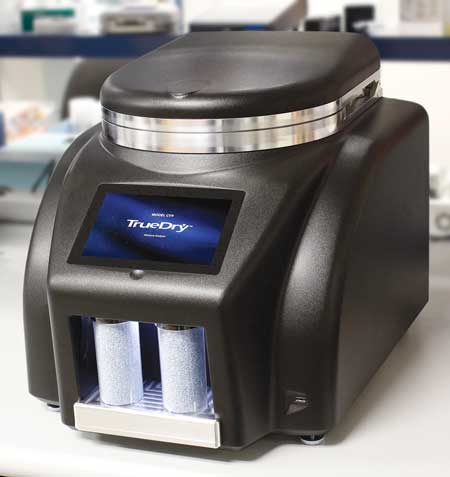 New moisture meter technology supersedes conventional drying ovens. TrueDry CV-9, a high precision moisture meter, accurately measures the moisture content of nine samples in just four minutes. The device features new technology that attains previously impossible drying standards by utilizing desiccated air to achieve 1% relative humidity. Also, TrueDry monitors sample weight by cycling each sample onto a high precision electromagnetic balance. AquaLab by Decagon, www.aqualab.com, Booth 1941
New moisture meter technology supersedes conventional drying ovens. TrueDry CV-9, a high precision moisture meter, accurately measures the moisture content of nine samples in just four minutes. The device features new technology that attains previously impossible drying standards by utilizing desiccated air to achieve 1% relative humidity. Also, TrueDry monitors sample weight by cycling each sample onto a high precision electromagnetic balance. AquaLab by Decagon, www.aqualab.com, Booth 1941
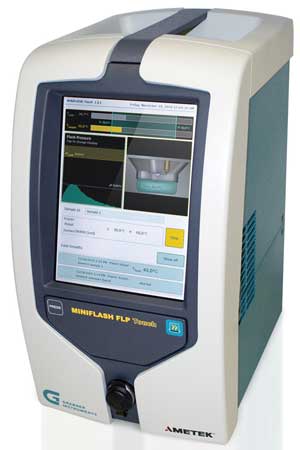 Portable device is designed to test flavors and fragrances. The Miniflash Touch is a portable analyzer that provides easy flashpoint testing of flavors and fragrances. The device includes a touch-screen design, runs on Microsoft Windows, and has full remote operation. Compatible with network, PC and LIMS, and USB printers, the Miniflash Touch requires a small sample volume of just 1 mL and is the latest addition to the Grabner Instruments line. Ametek Petrolab Co., www.petrolab.com, Booth 4712
Portable device is designed to test flavors and fragrances. The Miniflash Touch is a portable analyzer that provides easy flashpoint testing of flavors and fragrances. The device includes a touch-screen design, runs on Microsoft Windows, and has full remote operation. Compatible with network, PC and LIMS, and USB printers, the Miniflash Touch requires a small sample volume of just 1 mL and is the latest addition to the Grabner Instruments line. Ametek Petrolab Co., www.petrolab.com, Booth 4712
Microbiological tests screen for food pathogens and food safety. Accugen Laboratories Inc. analyzes food and feed for microbes that compromise food safety, ensuring the safety and quality of food products. The FDA-registered company provides authoritative testing services for bacteria, mold, and sanitation as well as monitoring of food environments. Accugen Laboratories Inc., www.accugenlabs.com, Booth 4713
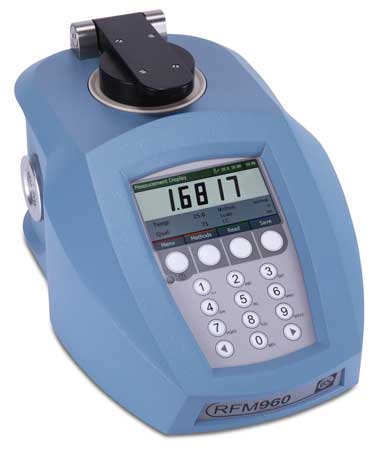 A controlled refractometer delivers thermally stable results. The new RFM960-C Peltier temperature-controlled refractometer provides results up to four decimal places across a wide refractive index range. With up-to-date instrumentation technology, the device provides clever guidance through a high-definition four-inch color display and can save more than 4,000 results. The refractometer device can also export results as PDF files via USB device. Bellingham + Stanley, a Xylem Brand, www.bellinghamandstanley.com, Booth 4409
A controlled refractometer delivers thermally stable results. The new RFM960-C Peltier temperature-controlled refractometer provides results up to four decimal places across a wide refractive index range. With up-to-date instrumentation technology, the device provides clever guidance through a high-definition four-inch color display and can save more than 4,000 results. The refractometer device can also export results as PDF files via USB device. Bellingham + Stanley, a Xylem Brand, www.bellinghamandstanley.com, Booth 4409
Courses and training for food safety allow food industry players to elevate their business. AIB International provides online training, manuals, and consultation in food safety, food defense, sanitation management, GMP inspections, and food labeling. The company also provides consultation for environmental monitoring programs. AIB International, www.aibonline.com, Booth 3156
--- PAGE BREAK ---
Direct testing methods analyze samples. CEM Corp. offers rapid process control testing equipment that analyzes moisture, fat, protein,and ash content. The Hybrid Trac has second-generation NMR technology that provides accurate results in only two minutes for dry samples. The device has an intuitive touch-screen interface and requires no costly calibration maintenance. In addition, changes in additives, color, or granularity in samples does not affect accuracy of results. CEM Corp., www.cem.com, Booth 4221
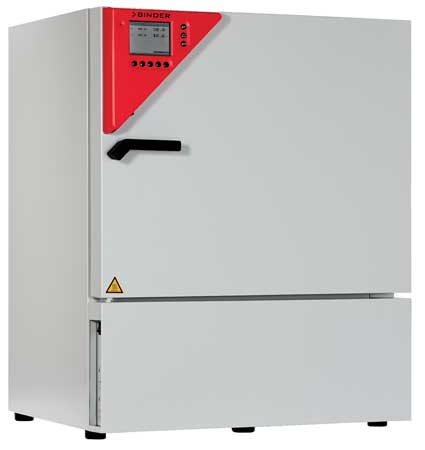 Humidity chambers test shelf life. KBF Series humidity test chambers ensure accurate shelf life testing with precise condition maintenance. Each unit’s temperature ranges 0°C to 70°C without humidity and 10°C to 70°C with humidity. The unit can store 25 programs and up to 500 program segments for testing of long-term storage, shelf life, and refrigeration. The chambers are available in sizes ranging from 4.1 cubic feet to 25.4 cubic feet. BINDER Inc., www.binderworld.us, Booth 5323
Humidity chambers test shelf life. KBF Series humidity test chambers ensure accurate shelf life testing with precise condition maintenance. Each unit’s temperature ranges 0°C to 70°C without humidity and 10°C to 70°C with humidity. The unit can store 25 programs and up to 500 program segments for testing of long-term storage, shelf life, and refrigeration. The chambers are available in sizes ranging from 4.1 cubic feet to 25.4 cubic feet. BINDER Inc., www.binderworld.us, Booth 5323
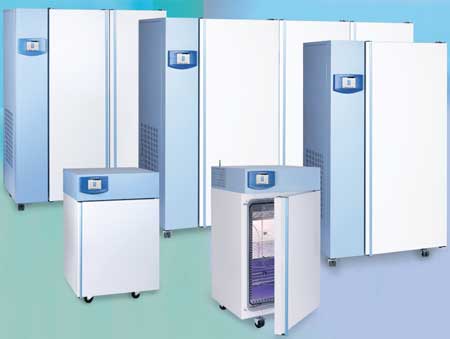 Patented forced air is a feature on these chambers. The Climacell EVO Stability Chamber with patented forced air have user-friendly applications that supply exact and reproducible simulation of environmental conditions. The instrument offers adjustable parameters, including a temperature range of -20°C to 99.9°C, a humidity range of 10% to 95%, LED lighting, CO2 regulation, and sterilization at 160°C. The Friocell EVO Incubator also has patented forced air as well as a color touch screen, double-chamber design, and precise temperature control from 0°C to 99.9°C. BMT USA, www.bmtus.com, Booth 4659
Patented forced air is a feature on these chambers. The Climacell EVO Stability Chamber with patented forced air have user-friendly applications that supply exact and reproducible simulation of environmental conditions. The instrument offers adjustable parameters, including a temperature range of -20°C to 99.9°C, a humidity range of 10% to 95%, LED lighting, CO2 regulation, and sterilization at 160°C. The Friocell EVO Incubator also has patented forced air as well as a color touch screen, double-chamber design, and precise temperature control from 0°C to 99.9°C. BMT USA, www.bmtus.com, Booth 4659
Software for sensory science and consumer interaction provide innovative services. Compusense at-hand, a sensory software, is a secure web-based sensory testing application that allows users to collect data from consumers wherever they are. The application has a library of template tests, or users can customize questionnaires by using the software’s drag-and-drop interface. The program can also be accessed on smartphones and tablets. Compusense, www.compusense.com, Booth 2112
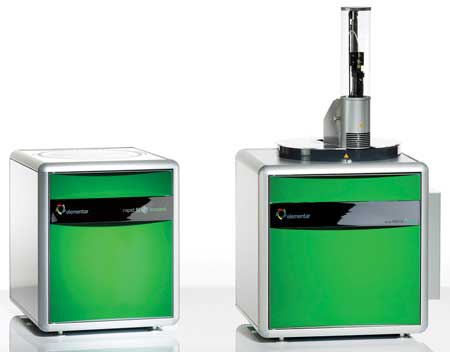 Small instrument provides big protein analysis. The Rapid N Exceed and Rapid Max Exceed analyze protein samples with low maintenance, automated ash removal, and reduced operating costs. Each device takes up less than 22 inches of bench space and features updated safety measuring by using all-steel combustion and reduction tubes. In addition, both devices eliminate the need for helium as a carrier gas. Elementar Americas Inc., www.elementaramericas.com, Booth 1509
Small instrument provides big protein analysis. The Rapid N Exceed and Rapid Max Exceed analyze protein samples with low maintenance, automated ash removal, and reduced operating costs. Each device takes up less than 22 inches of bench space and features updated safety measuring by using all-steel combustion and reduction tubes. In addition, both devices eliminate the need for helium as a carrier gas. Elementar Americas Inc., www.elementaramericas.com, Booth 1509
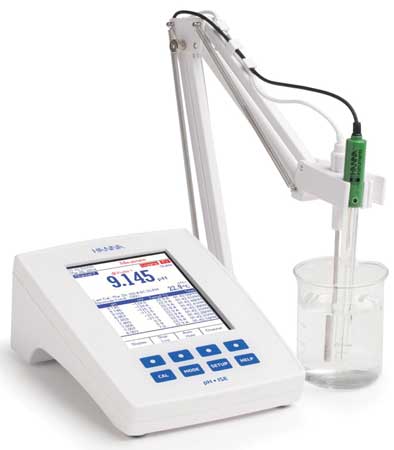 This advanced benchtop meter is customizable. The HI 5222 pH and temperature dual-channel meter is sized for benchtop use, customizable, and easy to use. The instrument is equipped with improved logging, data storage, and data transfer capabilities and can be calibrated up to five decimal points with eight pre-programed buffers or five custom buffers. It also features a large color LCD screen, a USB port, and Hanna Instruments’ CAL Check, which monitors potential problems with pH calibration. Hanna Instruments, www.hannainst.com, Booth 5080
This advanced benchtop meter is customizable. The HI 5222 pH and temperature dual-channel meter is sized for benchtop use, customizable, and easy to use. The instrument is equipped with improved logging, data storage, and data transfer capabilities and can be calibrated up to five decimal points with eight pre-programed buffers or five custom buffers. It also features a large color LCD screen, a USB port, and Hanna Instruments’ CAL Check, which monitors potential problems with pH calibration. Hanna Instruments, www.hannainst.com, Booth 5080
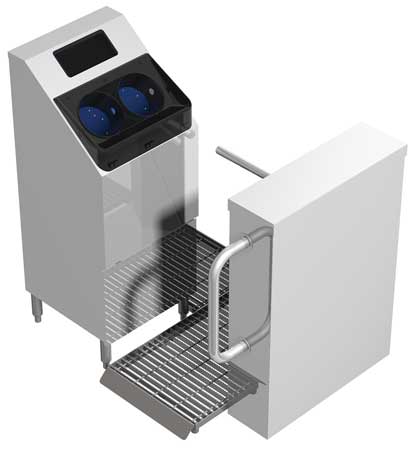 Hand-washing system raises the bar. The CleanTech 2000SCA Automated Hand-Washing System ensures complete control of hand hygiene. The system has a compact design with a turnstile that automatically opens at the end of each 12-second wash and rinse cycle and uses 75% less soap and water than manual washes. It also removes 99.98% of dangerous pathogens from bare skin and gloved hands. Meritech, www.meritech.com, Booth 4621
Hand-washing system raises the bar. The CleanTech 2000SCA Automated Hand-Washing System ensures complete control of hand hygiene. The system has a compact design with a turnstile that automatically opens at the end of each 12-second wash and rinse cycle and uses 75% less soap and water than manual washes. It also removes 99.98% of dangerous pathogens from bare skin and gloved hands. Meritech, www.meritech.com, Booth 4621
Special brushes help control contamination. Hill Brush Inc. makes brushes that do more than effectively clean production equipment; they also resist filament loss. Hill Brush’s dual retention system secures brush tufts in place by combining stainless steel staples with an epoxy resin that permeates deep into the tuft area. The resin contains an active antimicrobial ingredient that inhibits the growth of mold, mildew, and bacteria. Hill Brush Inc., www.hillbrushinc.com, Booth 4412
--- PAGE BREAK ---
High-quality instruments for testing physical properties and quality of materials are C.W. Brabender’s specialty. The company creates instruments for testing materials used by the milling, baking, and starch industries and is an industry leader in food extrusion. The Intelli-Torque Plasti-Corder makes use of CAN Field Bus Technology and can accommodate any C.W. Brabender mixer or extruder attachment. C.W. Brabender, www.cwbrabender.com, Booth 2173
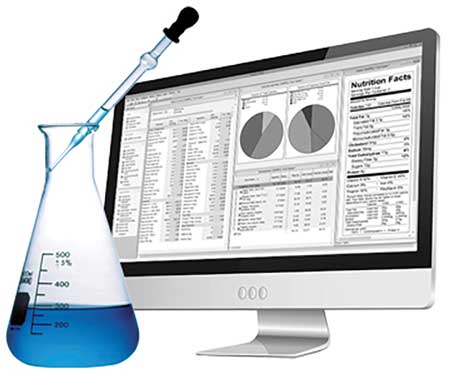 A suite of software products analyzes nutrition and makes labels. The Genesis R&D Food Analysis and Labeling software analyzes the nutritional content of product recipes and generates camera-ready nutrition facts panels. The program builds ingredient and allergen statements, features HACCP guidelines, and complies with country-specific government labeling laws. It also generates barcodes for labels. ESHA Research, www.esha.com. Booth 1027
A suite of software products analyzes nutrition and makes labels. The Genesis R&D Food Analysis and Labeling software analyzes the nutritional content of product recipes and generates camera-ready nutrition facts panels. The program builds ingredient and allergen statements, features HACCP guidelines, and complies with country-specific government labeling laws. It also generates barcodes for labels. ESHA Research, www.esha.com. Booth 1027
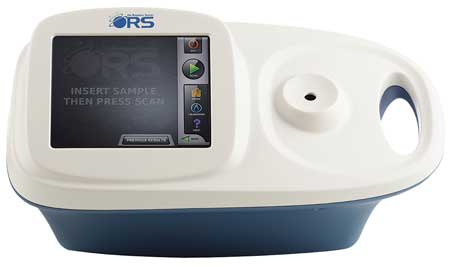 Rapidly obtain a precise sodium analysis. The MobiLab 130 is a portable elemental analyzer that measure sodium across a variety of food products. The device analyzes samples within 60 seconds, and neither clarity, color, nor the presence of ions affects its precision. The MobiLab 130 minimizes human error and eliminates the need for expensive reagents. One Resonance Sensors LLC, www.detect-ors.com, Booth 2284
Rapidly obtain a precise sodium analysis. The MobiLab 130 is a portable elemental analyzer that measure sodium across a variety of food products. The device analyzes samples within 60 seconds, and neither clarity, color, nor the presence of ions affects its precision. The MobiLab 130 minimizes human error and eliminates the need for expensive reagents. One Resonance Sensors LLC, www.detect-ors.com, Booth 2284
Particle-size analysis takes a step forward. The Partica LA-950 is a laser diffraction distribution analyzer that determines particle size in one minute with a powerful dispersion system, providing accuracy, precision, and resolution. The instrument has a revolutionary optical system design and a refined algorithm along with built-in automation and software that ensure reproducible results. Horiba Instruments, www.horibalab.com, Booth 4664
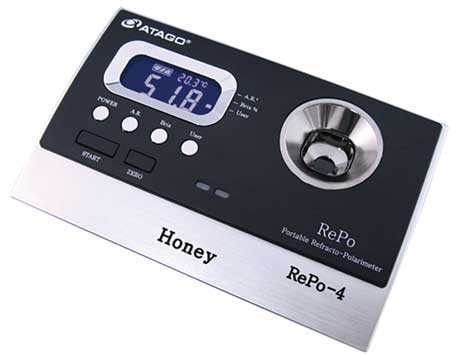 Portable refractometer and polarimeter makes its debut. The Atago RePo-4 Honey Total Analysis Model is a new refractometer and polarimeter that determines how fast honey crystallizes by measuring its fructose content. The device also determines the amount of moisture in a honey sample and provides Brix and temperature readings all in 12 seconds. Paul N. Gardner Co., www.gardco.com, Booth 3254
Portable refractometer and polarimeter makes its debut. The Atago RePo-4 Honey Total Analysis Model is a new refractometer and polarimeter that determines how fast honey crystallizes by measuring its fructose content. The device also determines the amount of moisture in a honey sample and provides Brix and temperature readings all in 12 seconds. Paul N. Gardner Co., www.gardco.com, Booth 3254
A handheld photometer can pair with a smartphone or tablet. The eXact iDip with Bluetooth Smart technology has the ability to test more than 35 parameters for water quality and can be used in food processing facilities. It requires a simple four-step process to get results in real time and has an app that allows users to connect wirelessly with portable smart devices. Industrial Test Systems Inc., www.sensafe.com, Booth 2127
Laboratory based in Wisconsin provides testing for the food industry. Marshfield Food Safety provides microbiological, chemical, nutritional, and allergen food testing as well as environmental monitoring in food production areas. The company is known for reliable results and fast turnaround times, giving customers accurate information at the right time. Marshfield also analyzes shelf-life expectancy, food processing procedures, and nutrition labels. Marshfield Food Safety, www.mfslabs.com, Booth 5156
The protein sector will be turned on its head. The In Vitro Protein Digestibility Corrected Amino Acid Score (PDCAAS) is a new service from Medallion Labs that safely measures the protein quality of alternative proteins in finished products. The new method reduces cost and turnaround times, delivers high accuracy and correlation, and eliminates the need to use animal feeding studies. PDCAAS allows users to compare protein ingredients, estimate final product protein claims, and check protein formulations. Medallion Labs, www.medlabs.com, Booth 2042
A comprehensive laboratory offers food testing. rTech Laboratories, a business unit of Land O’Lakes Inc., provides a complete array of analytical chemistry and microbiology testing, sensory and consumer research, nutrition labeling services, and information research services. rTech Laboratories, www.rtechlabs.com, Booth 2006
A leading provider of food safety and quality services now has two operations in Florida. Mérieux NutriSciences, formerly Silliker, has acquired ABC Research Holding Co. LLC in Gainesville, Fla., making it Mérieux NutriSciences’ second full-service laboratory operation in the region. Mérieux NutriSciences provides food-testing and consulting services, including microbiological analysis, nutrient analysis, sensory evaluation, training, and consulting services for regulatory issues. Mérieux NutriSciences, www.mxns.com, Booth 2118
--- PAGE BREAK ---
Ensure safety and quality of food with rapid testing. Neogen offers rapid, accurate, and easy-to- use onsite tests for food safety. Its line of rapid food safety products tests includes Soleris and BioLumix, which provide reliable results for microbiology testing, and Reveal 3-D food allergen kits, which are capable of detecting trace levels of food allergens in 10 minutes or less. The company also provides offsite laboratory testing services at its locations in Lansing, Mich., and Ayr, Scotland. Neogen Corp., www.neogen.com, Booth 4215
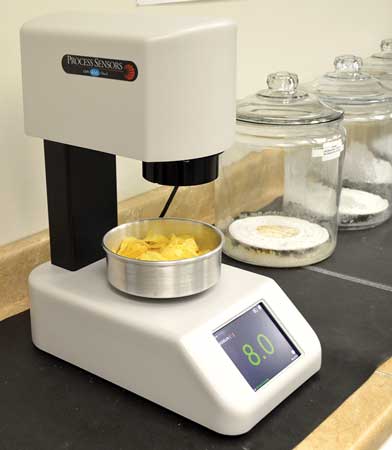 At-line and desktop moisture and oil gauges are available. Process Sensors has two stainless-steel moisture and oil gauges for the food industry. The MCT466-SF is a robust, reliable near infrared gauge that determines moisture content of products on conveyor lines. The MCT466 QuikCheck is a near infrared desktop tester that measures moisture as well as oils, protein, film thickness, nicotine, and sugars. Both devices feature a touchscreen display. Process Sensors Corp., www.processsensors.com, Booth 343
At-line and desktop moisture and oil gauges are available. Process Sensors has two stainless-steel moisture and oil gauges for the food industry. The MCT466-SF is a robust, reliable near infrared gauge that determines moisture content of products on conveyor lines. The MCT466 QuikCheck is a near infrared desktop tester that measures moisture as well as oils, protein, film thickness, nicotine, and sugars. Both devices feature a touchscreen display. Process Sensors Corp., www.processsensors.com, Booth 343
Pasteurization system optimizes heating. The Macrowave Pasteurization System operates at a frequency of 40 MHz, providing optimal penetration and uniformity in heating. The device effectively kills microbes yet avoids harmful effects on product functionality. In addition, the Macrowave treatment process does not use noxious fumigants, so it requires no special labeling. Radio Frequency Co., www.macrowave.com, Booth 4319
More than 80 years of testing ensures reliability. NP Analytical Laboratories provides comprehensive chemistry and microbiology testing. The company’s portfolio of tests includes nutrition label tests that determine levels of trans fat, dietary fiber, and sugar alcohols; product and ingredient tests that profile sugar, gelatinized starch, fatty acids, etc.; and microbiology tests that screen for pathogens. NP Analytical Laboratories, www.npal.com, Booth 2124
A life sciences and technology company is dedicated to food safety and quality. Sigma Aldrich Co. analyzes food and beverage products to ensure safety and determine nutritional value and quality. The company’s Supelco and Fluka analytical products offer specialized solutions for food analysts to simplify sample preparation, cleanup, and analysis as well as increase detection of trace ingredients and harmful substances. Sigma-Aldrich Co. LLC, www.sigmaaldrich.com, Booth 2084
Manufacturer offers specialized lab instrumentation. Xylem Analytics provides field, portable, and online laboratory analytical instrumentation. The instruments address needs across the food and beverage cycle: screening water quality, ensuring quality control and safety for production and cold-chain distribution, monitoring temperature, and analyzing biochemistry. The company has meters, sensors, and analyzers for food and beverage, wastewater, environment, pharmaceuticals, and life sciences. Xylem Analytics, www.xylemanalytics.com, Booth 4409
 Neil H. Mermelstein, IFT Fellow,
Neil H. Mermelstein, IFT Fellow,
Editor Emeritus of Food Technology
[email protected]


